Greece › Athens › Archaeological Sites › Acropolis Tickets
By Santorini Dave
See Also
• Athens – Best Hotels
• Athens – Family Hotels
• Athens – Best Places To Stay
• Athens – Best Tours
• Athens – Best Museums
• Athens – Best Archaeological Sites
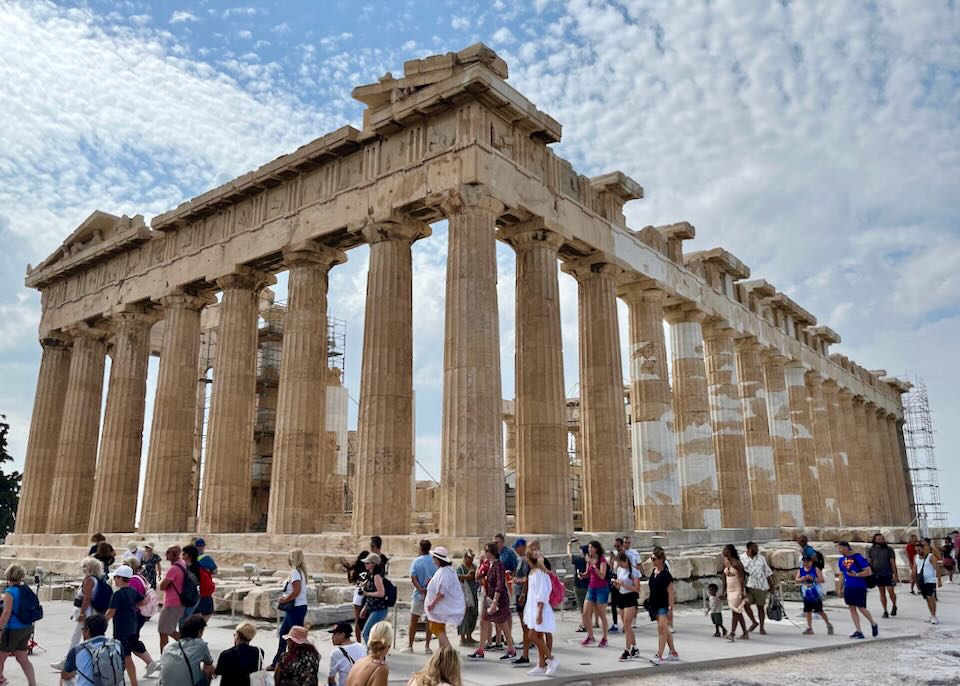
The Parthenon is the largest and most iconic structure on the Acropolis, and a must-see for any first time visitor to Athens.
Tickets & Tours for Acropolis & Acropolis Museum
The view of the Parthenon and Acropolis (my favorite cultural attractions in all of Europe) from the marvelous Acropolis Museum. A guided tour of both the Acropolis and the Acropolis Museum is the highlight of a visit to Athens.
Acropolis Hours and Information
- Acropolis Hours:
- Summer (April 1 – Oct 31): 8:00 am to 8:00 pm daily. (Note: Starting Sept 1, closing times shorten by 30 mins every two weeks, ending at 6:00 pm by late October).
- Winter (Nov 1 – March 31): 8:00 am to 5:00 pm daily.
- Last Entry: 30 minutes before closing.
- Closed: January 1, March 25, May 1, Easter Sunday, December 25-26.
- Museum Hours:
- Summer (April 1 – Oct 31): Monday 9:00 am – 5:00 pm; Tuesday–Sunday 9:00 am – 8:00 pm; Friday 9:00 am – 10:00 pm.
- Winter (Nov 1 – March 31): Monday–Thursday 9:00 am – 5:00 pm; Friday 9:00 am – 10:00 pm; Saturday–Sunday 9:00 am – 8:00 pm.
- Website: hhticket.gr (Official ticket site)
- Location: Central Athens
- Telephone: +30 210 3214172
- Admission Fee: €30 (Year-round). The previous winter discount for general admission was discontinued in 2025.
- Reduced (€15): Available for non-EU youths (age 6-25) and EU seniors (65+).
- Free: Children 5 and under (all nationalities) and EU youths (under 25).
- Free Entry Dates: March 6, April 18, May 18, last weekend of September, October 28, and the first Sunday of the month from November through March.
- Parking: There is no parking at the site. Use street parking or pay lots in the Koukaki/Makrygianni area.
- Nearest Metro: Acropoli (Red Line 2) is closest to the main South Slope entrance. Monastiraki (Blue/Green Line) is a 15-minute walk to the western entrance.
The Acropolis in Athens
The majestic Athens Acropolis
- The Acropolis is the most recognized site in Greece and the symbol of Western civilization. It is a must-see and the single best thing to do in Athens.
- The Acropolis Museum is the essential companion to the site. Opened in 2009, this world-class modern museum houses every artifact found on the Sacred Rock, from the Bronze Age to Byzantine Athens. I strongly recommend visiting the Acropolis site first (early morning), then cooling off in the museum afterwards. A guided tour of both is the best way to understand the connection between the ruins and the masterpieces.
Entrance to the Acropolis Museum, located just 300 meters from the Acropolis South Slope entrance.
- The Acropolis (meaning “High City”) is the ancient citadel located on the rocky outcrop above Athens. While it contains the remains of several ancient buildings, the most famous is the Parthenon. Your ticket also includes access to the North and South Slopes, home to the Erechtheion, the Temple of Athena Nike, and the Odeon of Herodes Atticus theater.
- Important Tip: You must now book a specific time slot online in advance for your visit. You can only enter the site 15 minutes before or after your selected time.
- The closest metro station is Acropoli (Line 2). It is located directly across the street from the Acropolis Museum and about 100 meters from the South Slope entrance of the archaeological site.

The view of the Acropolis Museum (the large grey modern building just beyond the Theatre of Dionysus) from the Acropolis. It’s a short walk between these two must-see attractions.
Prominent structures on the Athens Acropolis
The Parthenon is a marble temple that was dedicated to Athena, goddess of wisdom, arts, literature, and war. Construction of the Parthenon started in 477 BC. It was completed almost 40 years later in 438 BC. Although a little battered, the Parthenon has withstood earthquakes, fire, wars, and explosions throughout centuries. It was partially destroyed in 1687 during the Ottoman-Venetian War, when it was hit by a cannonball that exploded because gunpowder was being stored inside.
The ancient main entrance hall to the Acropolis complex, the Propylaea is located on the west side of the hill. It was designed between 437–432 BC by the Athenian architect Mnesicles.
The Temple of Athena Nike is on the southwest corner of the Acropolis. It was built around 420 BC. Nike is Greek for “victory”. Athena was worshiped in this form, representing victory in war.
The Temple of Erechtheion is on the north side of the Acropolis and is dedicated to Athena and the god Poseidon. It was built around 406 BC. The female figures that support the entablature of the temple are known as Caryatids, from the Greek term for “maidens from Karyai”, an ancient Peloponnese town.
The Odeon of Herodeion theatre is located on the Acropolis’ southwest slope. The building was completed in 161 AD, destroyed in 267 AD, and renovated and reconstructed in 1950. Theatrical performances and concerts still take place here.
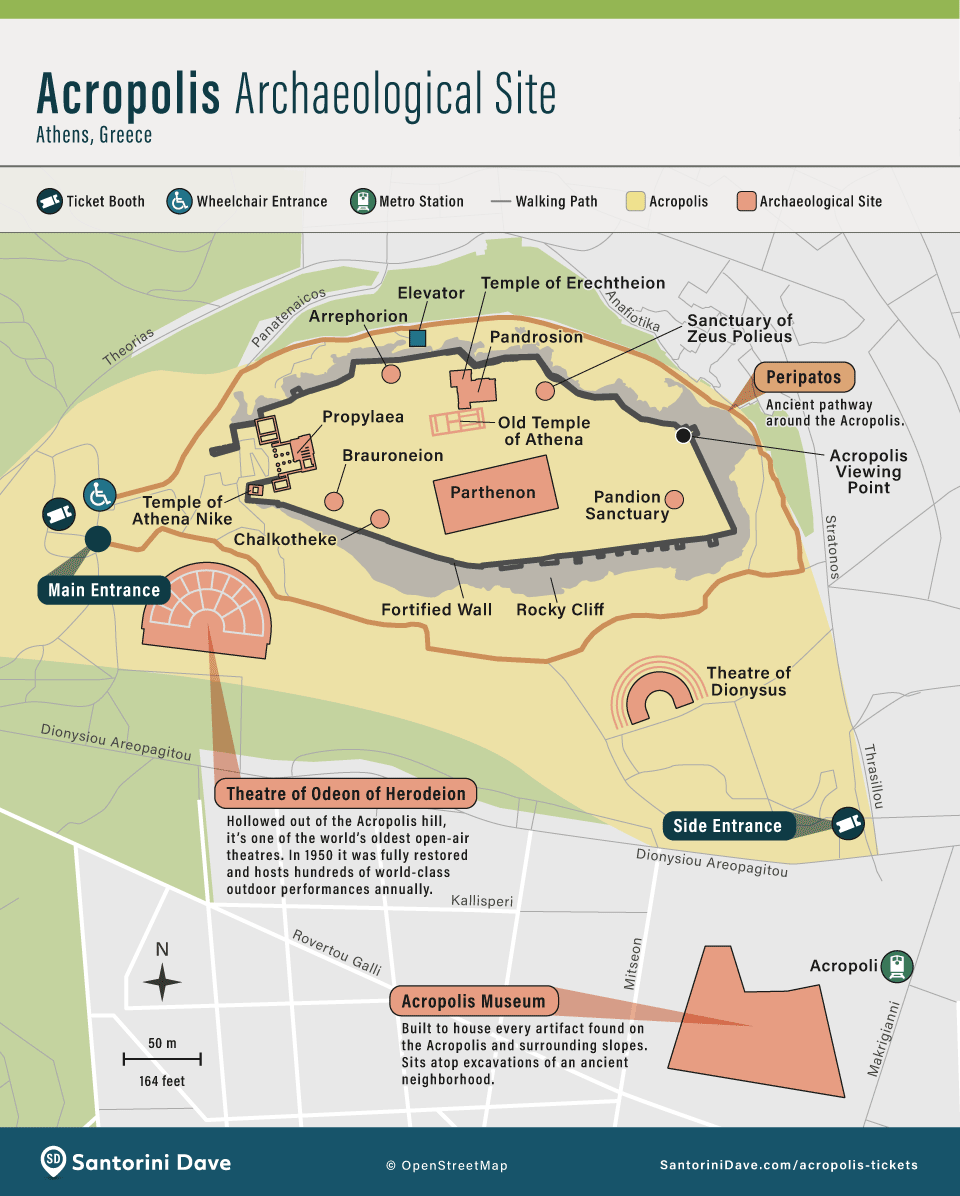
Athens Acropolis FAQ
How much are Acropolis tickets?
As of July 2025, the ticket prices for the Acropolis in Athens vary based on age, country of origin, and the time of year. Here is a breakdown of the costs.
High Season (April 1 to October 31)
• Standard Adult Ticket: €30
• This is the general admission price for adults (age 25+) visiting during the peak tourist season.Children & Youth (Non-EU): €15
• Youth aged 6 to 25 from countries outside the European Union receive a 50% reduction. Proof of age and country of origin (a passport) is required.Children & Youth (EU): Free
• Children and young adults up to the age of 25 who are citizens of a European Union country receive free admission. They must present a valid ID or passport to verify their age and nationality.Children Under 5: Free
• Children up to the age of 5 from all countries are granted free entry.Low Season (November 1 to March 31)
• During the winter months, the standard admission price is reduced by 50% for everyone.
• Standard Adult Ticket: €15
• Non-EU Children’s Ticket: €7.50
• All other discounts and free entry rules for children and youth typically still apply.Important Information:
• Proof of Eligibility: To receive any discount or free entry, you must present a valid form of identification (ID card or passport) at the ticket office. It’s recommended to have this ready.
• Mandatory Time Slot: All tickets for the Acropolis, including free and reduced-price tickets, require a specific time slot for entry. It is crucial to book your tickets online in advance to secure your preferred time.
• Acropolis Museum is Separate: The ticket for the Acropolis archaeological site does not include entry to the Acropolis Museum. You must purchase a separate ticket to visit the museum.
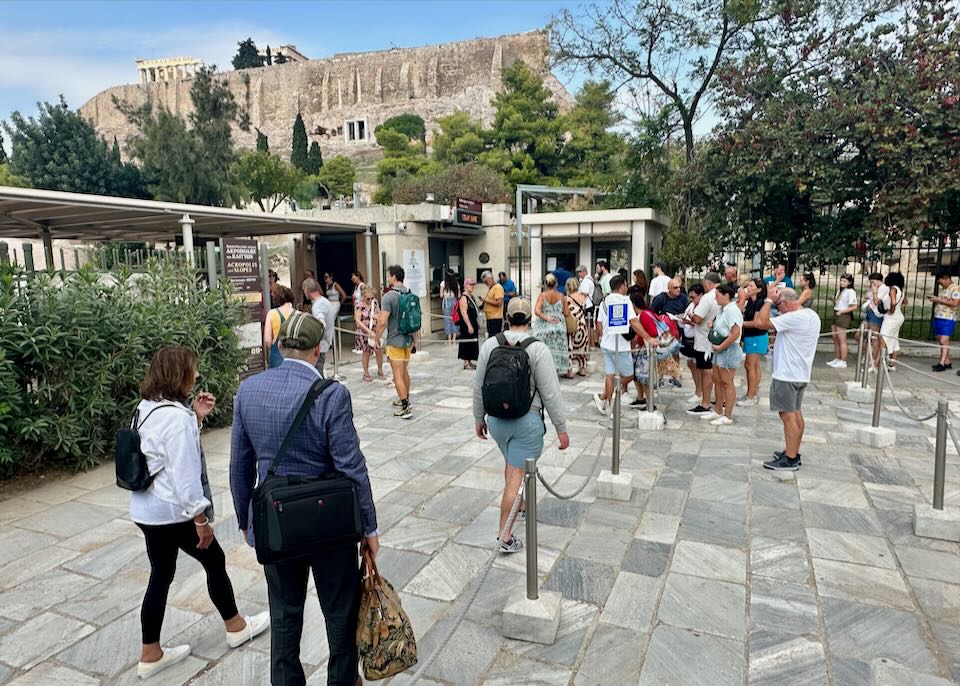
This is the eastern entrance to the Acropolis complex, located under the ruins of the Theatre of Dionysus and just a short walk from the Acropolis Museum.
Can you buy tickets to the Acropolis online?
Yes, you can buy tickets to the Acropolis online. Just keep in mind that you can’t buy tickets ahead of time for the following season. You can only buy summer tickets from April 1 to October 31, and you can only buy winter tickets from November 1 to March 31.
To purchase your tickets, all you need to do is to visit the Hellenic Heritage e-ticket portal. Once there, select “Acropolis and Slopes” and choose the date and time you wish to visit. Alternately, you can purchase Acropolis skip-the-line tickets from 3rd parties (like Tiqets) that cost a little more but have a much better user experience and are easier to get refunded should that be necessary.
Note: Booking tickets online – through the Hellenic Ministry or otherwise – will only help you avoid the (often very long) ticket-booking line and not the entrance line to the Acropolis. In order to avoid the entrance queue, you’ll have to opt for a guided tour of the Acropolis.
What does an Acropolis ticket include?
A single-use Acropolis ticket will grant you access to the Acropolis, including the Parthenon, Erechtheion, and other monuments at the top, as well as those on the Acropolis’ North & South Slopes – like the Odeon of Herodeion theatre.
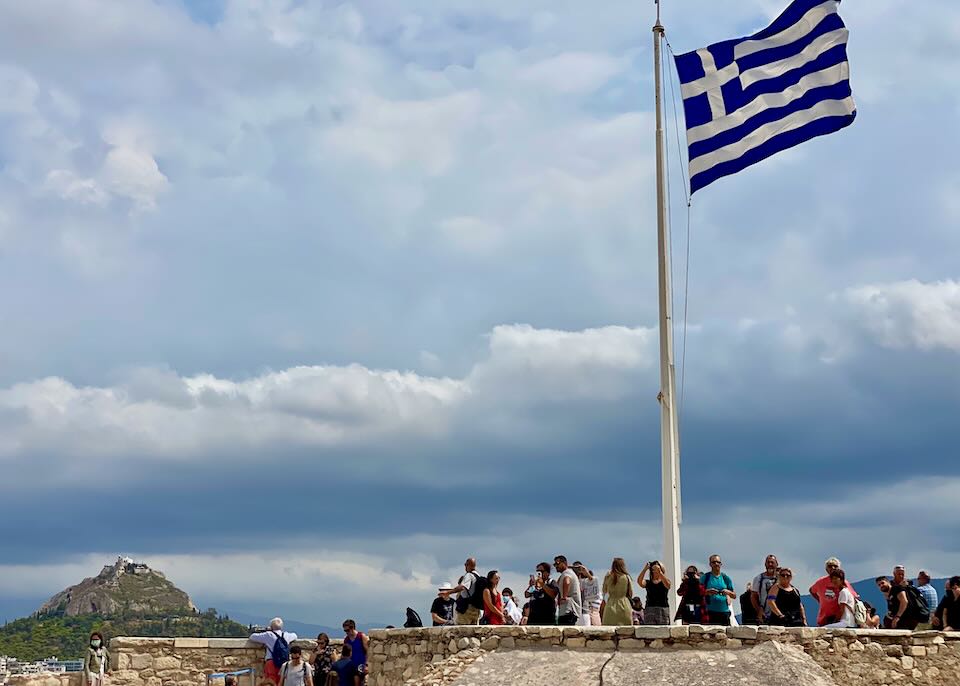
On certain days of the year, such as International Monuments and Museums Days and European Heritage Days, admission to the Acropolis is free for everyone.
Can you see the Acropolis for free?
Anyone can also visit the Acropolis for free on the following days:
- March 6 (Melina Mercouri Remembrance Day)
- April 18 (International Monuments Day)
- May 18 (International Museums Day)
- The last weekend of September (European Heritage Days)
- October 28
- Every month’s first Sunday between 1st November & 31st March
Children under 5 from any country get in for free at any time, as do kids, teens, and young adults under 25 from EU countries.
Is the Acropolis free on Sundays?
That depends on the time of year you visit. During the winter (November 1 to March 31), entry to the Acropolis is free on every first Sunday of the month. In the summer months (April 1 to October 30), entrance is not free on first Sundays.
Do you need skip the line tickets for Acropolis?
We strongly recommend skip-the-line tickets to the Acropolis to save time, energy, and hassle but they are not mandatory.
Do I need to buy Acropolis tickets in advance?
Buying Acropolis tickets in advance is recommended but it is not mandatory. In-person tickets are for sale near the two entrance gates of the Acropolis. Be prepared for long lines to purchase tickets, however, especially since, as of 2025, there is a cap on how many visitors will be let in to the site every hour.
The ticket line at the Acropolis can often be 1 to 2 hours long. I highly recommend buying skip-the-line tickets online and in advance.
Where can I buy Acropolis tickets?
Tickets can be purchased online, from either the Hellenic Heritage e-ticket portal or third-party sites (skip-the-line tickets are recommended), or you can go to the entrance gates and purchase the tickets from the ticket counter. Acropolis tours will also include Acropolis tickets. Whatever option you choose, it’s advisable to purchase the tickets online; the Acropolis ticket-office queue is often quite long, with a wait of 1-2 hours until you get your hands on the ticket.
Is the Acropolis Museum worth it?
Yes, the Acropolis Museum is definitely worth a visit. It’s one of the best museums in Greece and deserves at least two hours to tour – though history lovers could easily spend the better part of a day inside. The Acropolis and Acropolis Museum Tour (with skip-the-line tickets) is an easy and efficient way to see both attractions.
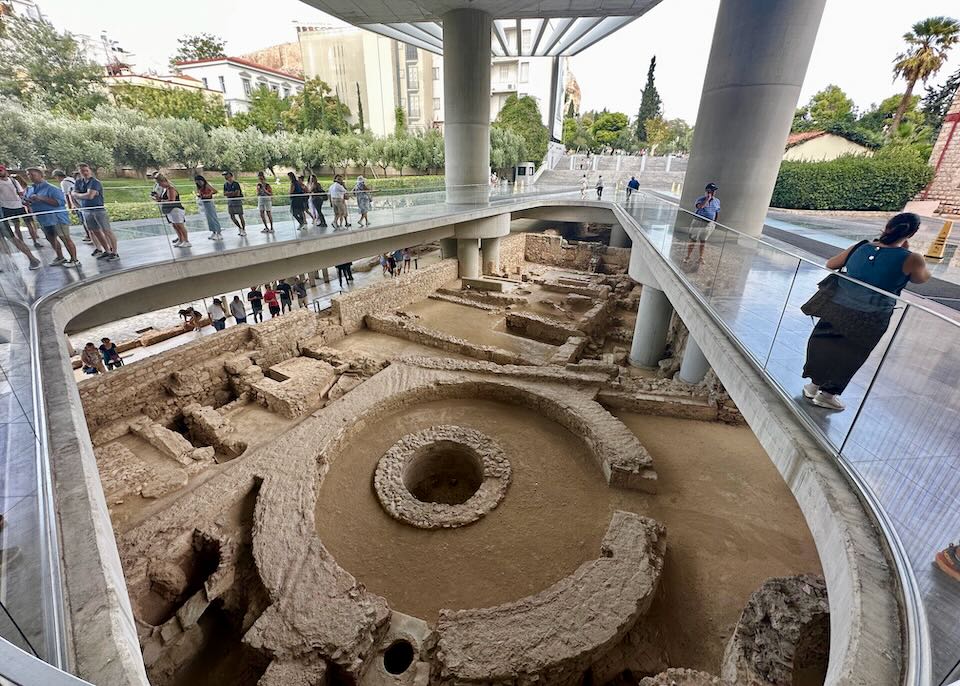
The excellent Acropolis Museum not only contains priceless treasures and artifacts from the Acropolis and its slopes, but it is also an archaeological site itself. It was built atop columns over of the ruins of an ancient Athenian neighborhood, which is now open for visitors to explore.
What should I wear to the Acropolis?
There aren’t any restrictions on clothing for visiting the Acropolis. You can wear anything you like. Though there is no strict dress code, it’s best to use common sense. A climb up the hill during the hot summer months makes light, casual clothes a better choice than heavier or more formal wear. There is little vegetation in the area and lots of marble, so a midday visit can be bright and often hot. As for footwear, flip-flops are not allowed. Choose comfortable shoes with good tread, because the steps are made of marble and can be slippery, and much of the ground at the top is covered in uneven stones. The Acropolis is an important historic and cultural site for Greeks so while shorts and tank tops are fine, showing good taste and some modesty is always recommended.
How difficult is it to climb the Acropolis?
The Acropolis sits on a hilltop high above the city of Athens, so you’re going to have to climb a bit to make it to the top. The walk to the top can take up to 15 minutes and involves a fairly steep incline. But the paths are wide and well maintained and there are plenty of spaces to pull to the side, catch your breath, and enjoy the views. Water and snacks are available for purchase at the top near the ticket kiosks but there are no snack shops after you enter the ticketed gates.
How many steps up the Acropolis?
The uphill route to the Acropolis consists of several sets of steps. The Acropolis is 150 m (500 ft.) above sea level and 70 m. (230 ft.) above the surrounding neighborhoods from which you will climb. You can expect to climb the equivalent of 200 steps to reach the entrance.
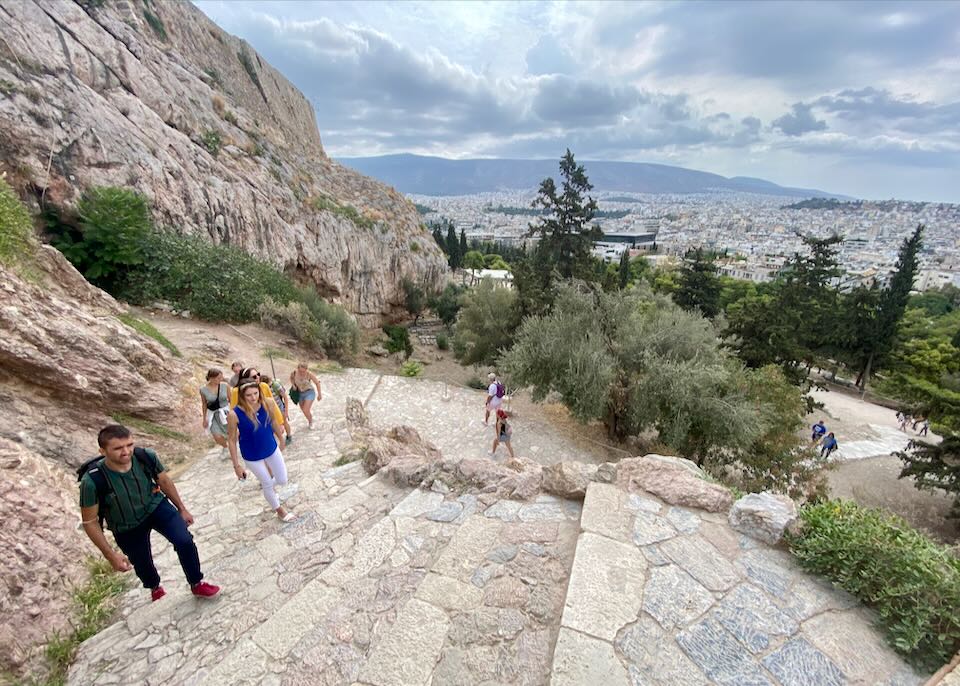
The marble stairs up to the Acropolis are uneven and can be slippery. Sturdy shoes are recommended.
Is the Acropolis Handicapped-Accessible?
Yes. There is a new (as of 2020) elevator for wheelchair users and people with disabilities located about 350 meters from Acropolis’ main entrance on the west side of the hill. Atop the Acropolis, new specially designed concrete paths allow wheelchair users and mobility-impaired visitors to access the Parthenon and other main structures. Handicapped-accessible restrooms can be found at both the foot and the top of Acropolis Hill.
Entrance to the Acropolis is free for people with disabilities. If the disability is not apparent, it’s a good idea to carry a physician’s note for verification.
What’s the difference between the Acropolis and the Parthenon?
The Acropolis is the name of the hill overlooking Athens on which numerous ancient monuments sit. The most recognizable building at the top of the hill is a temple called the Parthenon. The Ancient Greeks dedicated the Parthenon to the goddess Athena, who was viewed by the people of Athens as their patron.
What buildings are at the Acropolis?
The Acropolis is home to the following ancient buildings:
- The Parthenon
- The Propylaea
- The Erechtheion
- The Temple of Athena Nike
- The Old Temple of Athena
- The Pandrosion
- The Arrephorion
- The Chalkotheke
- The Brauroneion
- The Sanctuary of Zeus Polieus
- The Pandion Sanctuary
Other sites on the hill and on the North and South slopes of the Acropolis include:
- The Theatre of Dionysus
- The Odeon of Herodes Atticus (also called Herodeion or Herodion)
- The Peripatos (the ancient pathway that encircles the Akropolis)
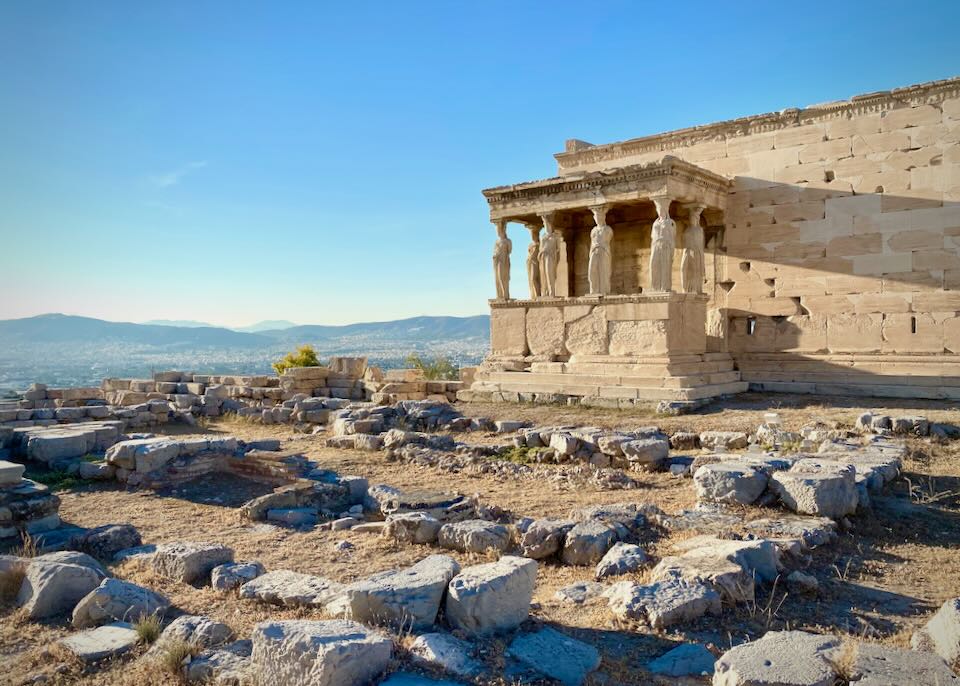
The Erechtheion Temple
Are there descriptions written in front of each building?
Unlike at a well-appointed museum that might have elaborate descriptions for each painting, you won’t interpretive placards, descriptions, or markings in front of most Acropolis buildings. In fact, the only building at the Acropolis with an extensive description provided to orient site visitors is the Propylaea, the complex’s monumental entrance gate. That’s one of a few good reasons we suggest opting for an Acropolis guided tour.
Can you walk up to or inside the Parthenon?
The Parthenon is an ancient temple that has braved the elements for centuries. As such, visitors are forbidden from walking onto the Parthenon itself to prevent further damage or erosion. Many visitors do like to see the Parthenon from all angles, so they walk around the entire circumference of the temple for a better, longer look.
What is the best time to visit Acropolis?
The Acropolis is one of the most famous landmarks in Athens and is prone to large crowds and lines, especially during the peak season (June-August). The busiest time is usually between 11:00 AM and 1:00 PM. If you want to avoid the largest crowds, book tickets in advance and arrive at the Acropolis entrance at 7:45 AM, 15 minutes prior to the opening time (8:00 AM). This should allow you a few hours to explore before the busy midday period. Crowds should start to thin around 3:00 PM making the late afternoon and early evening another good time to visit.
Your options are more flexible in the quieter wintertime season, though you’ll still find less traffic early in the morning and later in the day.
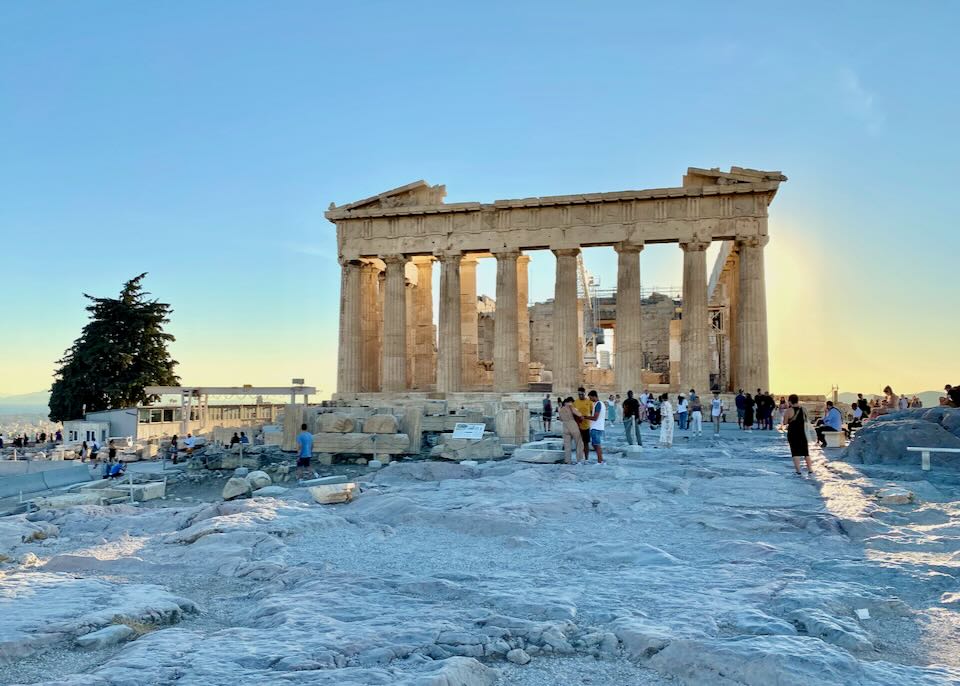
Visiting the Acropolis in the early morning or evening is recommended to avoid both the thickest tourist crowds and the midday heat.
Can you visit the Acropolis at night?
You cannot visit the Acropolis at night and for good reason: The steepness of the hill combined with darkness would create a major safety hazard, as would the uneven ground and loose stones at the top. The good news is that if you want to see the Acropolis at night, you can see it from anywhere in the city center because it’s lit up after the sun sets.
How long should you spend at the Acropolis?
If you’re counting the walk up the hill and back down again, budget 40 minutes for the round-trip walk. As for the time you’ll spend at the Acropolis itself, that depends on your sightseeing tendencies. If you just want to do a quick walk-through to say you’ve visited, you can see the Parthenon and other major sites on the hill in about an hour. A more thorough visit with moments of reflection, photos, reading from a guide book, or listening to an audio guide could easily fill two hours or more.
Do you need a tour guide for the Acropolis?
It’s not an absolute need by any means. Many people choose to walk around the hill on their own, taking in the sites. You can always use a guide book, audioguide, or scroll around on your smartphone to read about the key features of the Acropolis. That said, a good guide can certainly make the experience much richer and more memorable. If you traveled thousands of miles and spent thousands of dollars to visit Athens, a little more added expense for a good guide will be worth it. This is the guided tour of the Acropolis that I recommend.
Video of the Acropolis
This is a wonderful video on the history of the Acropolis and ancient Athens. Watch it twice. Once, before your trip and again the night before you visit the Acropolis when in Athens. There’s more great historical info from the Khan Academy here.
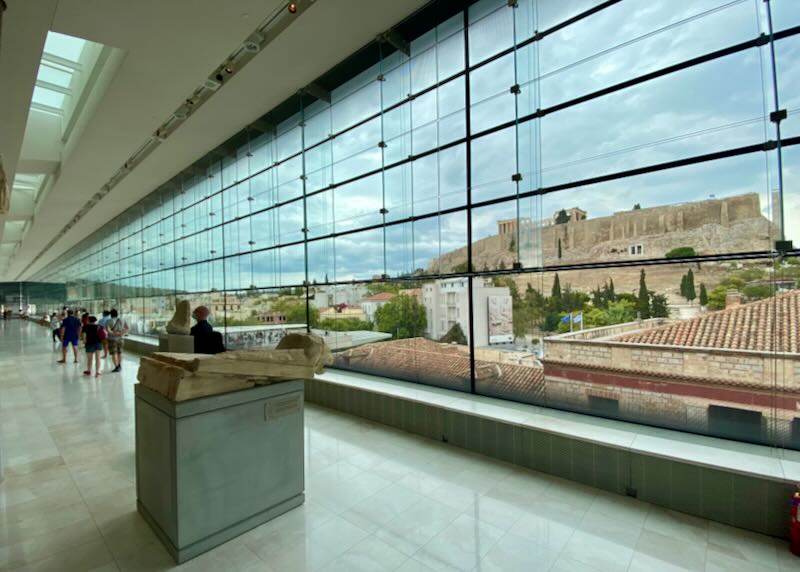
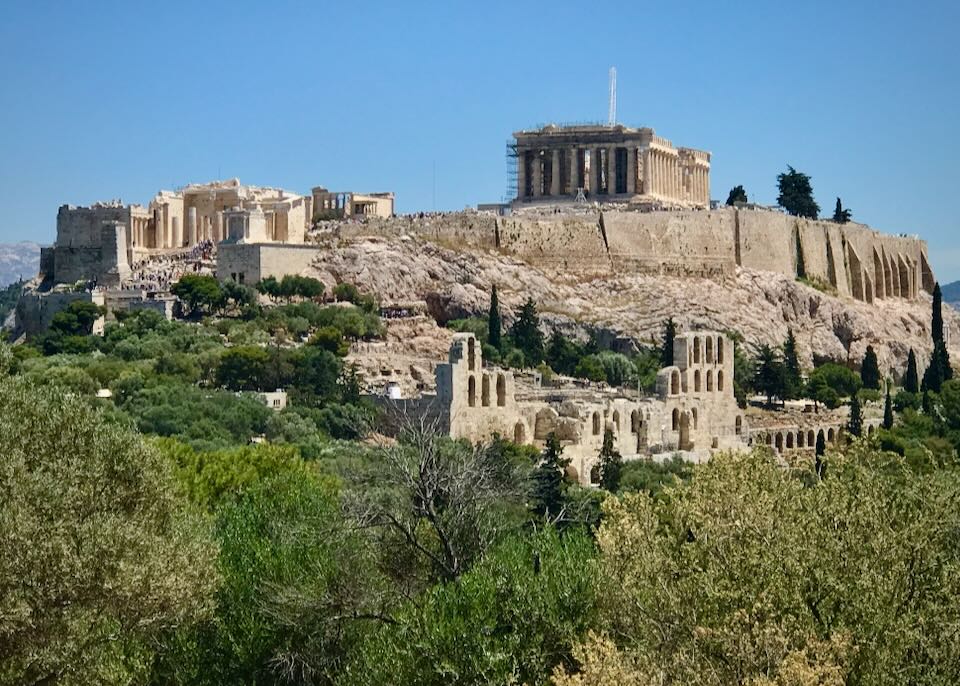
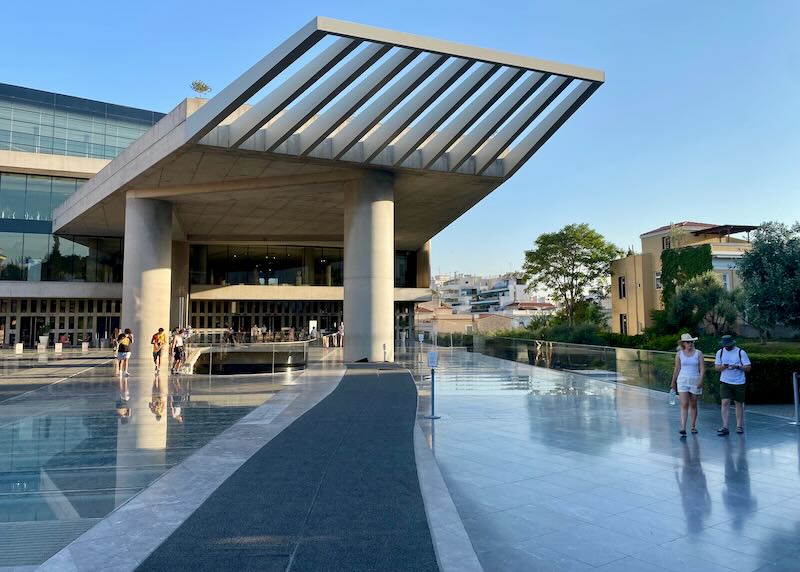
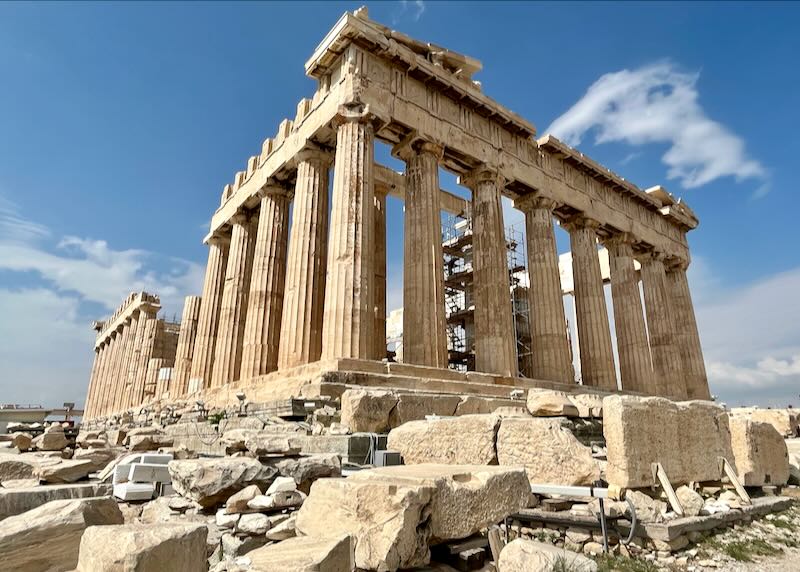
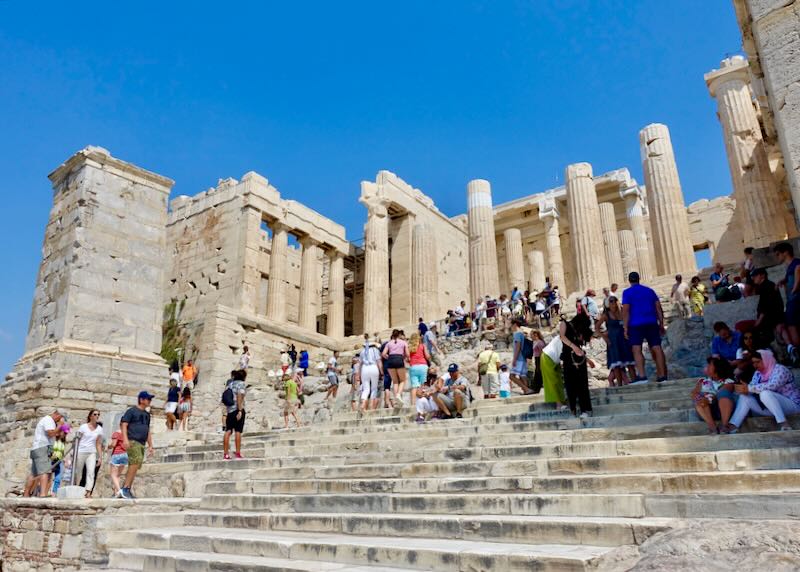
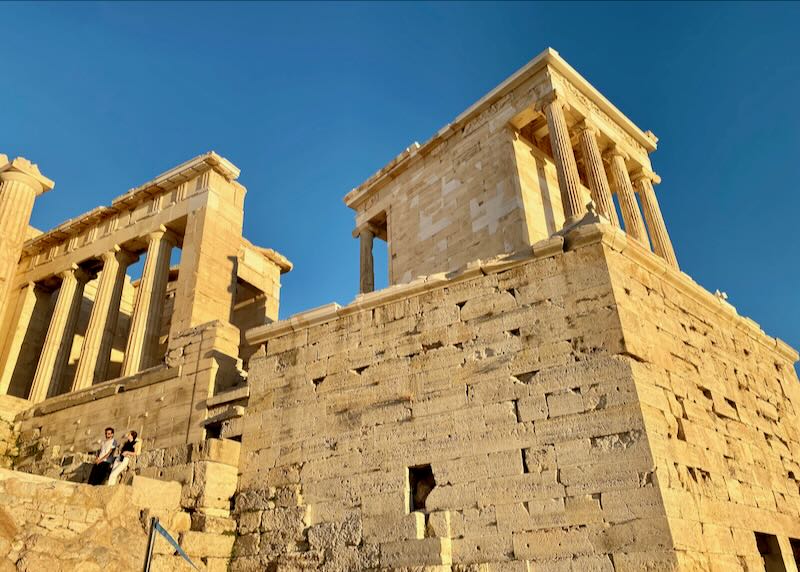

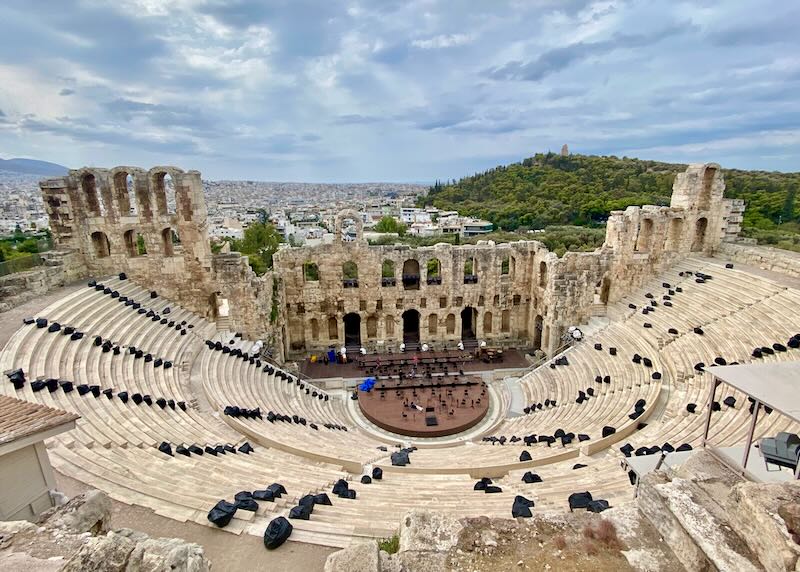
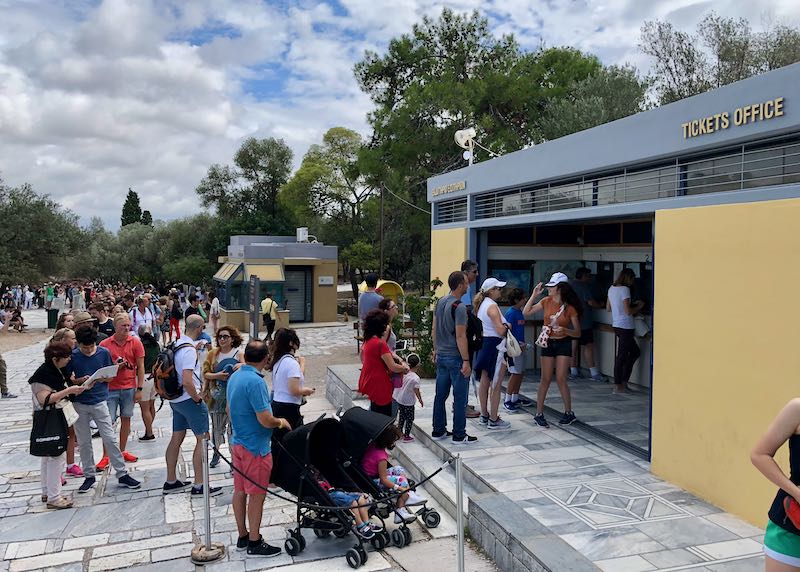
About Santorini Dave